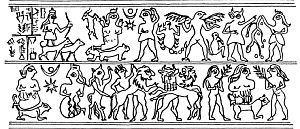
|
|
MesopotamiaAstronomy
|
|


Mesopotamian myths and legends around stars, planets and constellations are as old as
Mesopotamian astronomy, which dates back to the third millennium BC, the Early Bronze Age.
 The primary focus of this site is not astronomy, but Star Lore, which is folklore based upon stars and star patterns. We try to create a collection of mythical stories about stars and constellations from all over the world. However, to better understand and interpret the stories, a brief history of the astronomy of different cultures might be helpful.  This is by no means a scientific paper on the history of Mesopotamian astronomy, but merely an illustrated collection of highlights of that history, along with some links to what we think are reliable sources on the subject.  Click here to discover the world of astronomical mythology from Sumer, Babylon and other Mesopotamian locations. |


|
|
This portion of our site is about the history of Mesopotamian astronomy.
 Click here to discover the world of Mesopotamian Star Lore. |


Bits of History of Mesopotamian Astronomy |


|
|
Ancient Legends The first forms of writing emerged in Sumer in the late fourth millennium BC, but artwork depicting mythical creatures dates back far longer. |
 |

|
Aurochs and Lion at Babylon's Ishtar Gate (our own pictures)
|
Much of Mesopotamian artwork depicts bulls and lions (see pictures above), thus, not surprisingly, those animals were among the first astronomical figures.
 Source: J. H. Rogers: Origins of the ancient constellations: I. The Mesopotamian traditions |


|
|
Early Pictographs (ca. 3200 BC)
Around 3200 BC, three early zodiac constellations, lion, bull and scorpion had been defined. At that time, these constellations marked three
of the four cardinal points (both solstices and the spring equinox).
|
 Cylindrical seal from the Elamite capital Susa,
Cylindrical seal from the Elamite capital Susa,ca. 2500 BC; click image for description Source: J. H. Rogers |


|
|
Enuma Anu Enlil (ca. 1650 BC)
Enuma Anu Enlil, named after Anu, the
divine personification of the sky and Enlil, the god of wind, storm and earth, was a series of
tablets on astrology and omens in Babylon.
|
 Venus tablet of Ammisaduqa
Venus tablet of AmmisaduqaSource: Wikipedia |


|
|
Boundary Stones (ca. 1350 BC)
Boundary stones were records of land grands, calling onto the Gods to witness and protect the
ownership of land. They were introduced around 1350 BC during the Kassite dynasty.
|
 Top of a boundary stone, showing the trinity
Top of a boundary stone, showing the trinityof Moon, Sun and Venus and underneath (middle) the goatfish Capricornus Source: researchgate.net |


|
|
Enűma Eliš
In the Babylonian Epic of Creation, Marduk,
the patron deity of Babylon, fights the Chaos Monster Tiamat, the goddess of the salt sea. Marduk rips her in two parts. One part
he makes into the land. Out of the other part, he forms the heavens, which are set in three ways: The way of
Enlil (the northern hemisphere), the way of
Anu (the celestial equator) and the way of
Ea (the southern hemisphere).
|
 Chaos Monster and Sun God on a base relief at Nimrud
Chaos Monster and Sun God on a base relief at NimrudSource: Wikipedia |


|
|
Three Stars Each (ca. 1200 BC)
At around 1200 BC, Babylonian astronomers developed a farming calendar and catalogue of 36 "stars" - one for each of the Three Ways and for each month.
|
 Tabular Astrolabe B
Tabular Astrolabe BSource: Gary D. Thompson |


|
|
MUL.APIN (686 BC)
The MUL.APIN star catalog expanded the Three Stars Each list to 66 stars and constellations and
five planets. The table is named after the first word on it - mul.APIN (The Plough) stands for today's constellation Triangulum.
|
 MUL.APIN tablet
MUL.APIN tabletSource: Wikipedia |


|

|


|
|
The picture to the right shows the Babylonian Gods (from left to right) Ishtar of Arbela, Adad, Shamash, En-lil, Sin, Ishtar, and Asshur.
The table below shows the Babylonian names of the Zodiac constellations, the sun, the moon and the known planets.
|
 Rock relief at Malatia
Rock relief at MalatiaSource: Lewis Spence: Myths and legends of Babylonia & Assyria |


|
|
Aries Taurus Gemini Cancer Leo Virgo Libra Scorpio Sagittarius Capricorn Aquarius Pisces |
LU.ḪUN.GA GU4.AN.NA MAŠ.TAB.BA.GAL.GAL AL.LUL UR.GU.LA AB.SIN ZIB.BA.AN.NA GIR.TAB PA.BIL.SAG SUḪUR.MAŠ GU.LA
SIM.MAḪ or |
Agrarian Worker Divine Bull of Heaven Great Twins Crayfish Lion The Furrow Scales Scorpion Soldier Goat-Fish Great One
Tail of the Swallow or |
Sun Moon x Jupiter Venus Saturn Mercury Mars |
Shamash Sin x Marduk Ishtar Ninurta (Ninib) Nabu (Nebo) Nergal
|


|
|
Alexander's Empire (331 BC)
In October of 331 BC, the Persian Empire was defeated by the forces of Macedonian ruler Alexander the Great.
Click here for bits of the history of ancient Greek astronomy. Click here for bits of the history of ancient Egyptian astronomy. |
 Astronomical diary recording the death of Alexander the Great
Astronomical diary recording the death of Alexander the GreatSource: Wikipedia |


|
|
Halley's Comet (164 BC)
One of the last astronomical records in Cuneiform was a Babylonean clay tablet,
recording the appearance of a comet in September 164 BC.
|
 Babylonian record of 164 BC
Babylonian record of 164 BCBritish Museum in London Source: Wikipedia |


| Mesopotamian astronomy highly influenced the astronomy of Egypt, Greece and India |

| Forward to Ancient Egypt |
 |
Forward to Ancient Greece
|
|

Forward to Ancient India |
| 
|


|
Back to Star Lore |

Back to History |
Back to Space Page |
Back to English |
 Back to Start Page |